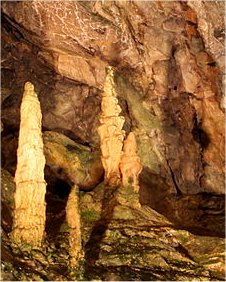
June Editorial
How stalagmites are helping us understand past climate changes in the western tropical pacific.

June Editorial
How stalagmites are helping us understand past climate changes in the western tropical pacific.
|
Understanding how the climate has changed in the past is essential for those constructing models to predict climate change in the future. But understanding past climates is easier said than done. There are only a handful of ways to study the climate of past ages, and fewer that allow accurate tracking of changes.
Tree rings are one such source, and the basic science (known as dendrochronology) is relatively easy. The number of rings within a tree trunk tell us the age of the tree. The shape of the rings tells us how wet a particular year was - the wider the rings, the rainier the year. Since all trees in an area are subject to the same climate, tree rings can give the weather of a particular year with remarkable accuracy. However, the major drawback of dendrochronology is that it does not go far back enough. Since dendrochronology relies on finding trees from a particular period in the past, most data comes from the last 1000 years.
|
Ice cores are another good way of examining past climate. Ice preserves a record of what was in the air when the water froze, be that carbon dioxide or ash particles from an active volcano. As snow is compressed into ice, the preserved layers tell us about the precipitation and even the temperatures of a given period. Scientists drilling into the ice can extract cores that are time capsules giving insights into the weather of the past. The oldest ice from Antarctica is about 800,000 years old, so time spans go back further than studies of tree rings. However, like dendrochronology, ice cores studies have drawbacks. By definition ice cores can only be taken from areas with permanent ice and such areas are of limited use for those studying climate change in the tropics. |
|
|
But there is a new kid in town - the stalagmite. Scientists are calling stalagmites the next generation of climate records. A stalagmite is a cave formation - a secondary mineral deposit which slowly rises from the floor of a limestone cave. It is created because water seeping through cracks in a cave’s surrounding bedrock dissolves certain compounds; usually calcium carbonate or calcium sulfate. Given the right acidity, the minerals start to precipitate from the water as it drips to the floor. The precipitate solidifies, giving rise to a stalagmite. Such cave formations grow very slowly, so a sizable stalagmite can have taken tens of thousands of years to develop. Each fragment of a stalagmite can be precisely dated and can give information about the water composition from which that fragment was formed. In one of the most recent studies, (ref 1) scientists led by Professor Kim Cobb from the Georgia Institute of Technology collected four stalagmites from different caves in Borneo. These stalagmites were then sliced and 1700 samples were analysed. The team used thorium and uranium in an isotope dating technique which allowed them to determine the precise age of each fragment. Such analyses are particularly difficult in samples from cave formations because the levels of the required isotopes are very low. In fact, until recently this was the most inhibiting factor in the dating of stalagmites. However with improved modern techniques this is no longer the case. Indeed, nowadays, speleothems (cave formations, of which stalagmites are one example) provide some of the best-dated of all climate records. The Borneo stalagmite samples were also analyzed for the ratio of oxygen isotopes contained in samples of calcium carbonate (the material from which the stalagmites were formed). That ratio is set by the oxygen isotopes contained in rainfall at the site. Professor Cobb’s group had already shown in their earlier studies that oxygen isotopic ratios in the water are good indicators of the amount of rainfall in a particular region. Putting all this data together can therefore provide an insight into climate changes and particularly rainfall amounts over a time span of 100,000 years. The researchers were particularly interested in the changes in the rainfall during three different types of events. These were:
Studies of the Borneo stalagmites revealed that the rainfall patterns in the region did not shift during Dansgaard-Oeschger excursions, but the Heinrich events did cause tropical rainfall to dry out. The Toba eruption also had a very significant effect. Very large volcanic eruptions normally cause so-called ‘volcanic winters’ which last from a few years up to two decades. Shockingly, studies of the Borneo stalagmites revealed that the dry period following the Toba eruption lasted for about 1000 years. A strong benefit of studying climate changes through stalagmites is that stalagmites are widespread. They are found in almost any part of the globe, and this means that the effects of abrupt climate events in different parts of the world can be compared. For example, previously published stalagmite climate records from China showed that both the Dansgaard-Oeschger excursions and Heinrich events significantly affected rainfall, which suggests that there are regional differences in how specific microenvironments are affected by abrupt global changes. As Professor Cobb commented: ‘To my knowledge, this is the first record that so clearly shows sensitivity to one set of major abrupt climate change events and not another... These two types of abrupt change events appear to have different degrees of tropical Pacific involvement, and because the tropical Pacific speaks with such a loud voice when it does speak, we think this is extremely important for understanding the mechanisms underlying these events.’ You can find out more about Professor Kimm Cobb’s research into stalagmites by visiting their website: http://shadow.eas.gatech.edu/~kcobb/research/stals/stals.html Journal Reference:
| |
| _______________________________ | ||||
| Home | | | Shopping | | | Database |
© Biscuit Software 2004-2015
All rights reserved